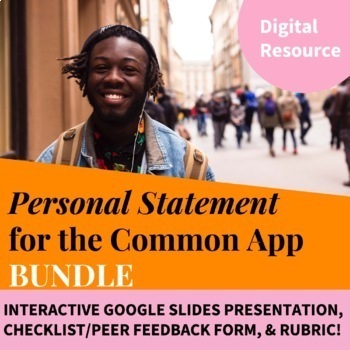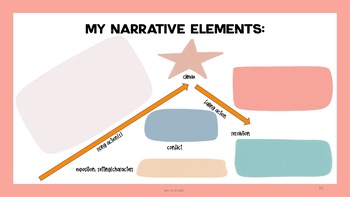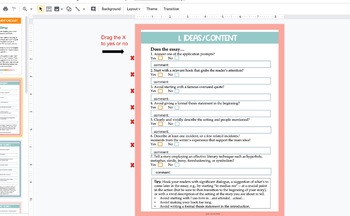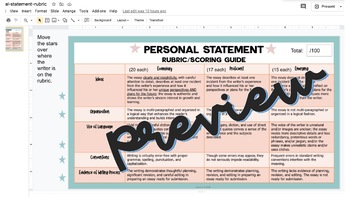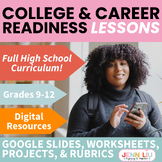College Essay - Personal Statement Lesson, Checklist, & Rubric BUNDLE
- Zip

Products in this Bundle (3)
Also included in
- Calling all high school AVID, Advisory, and college and career readiness teachers and counselors! Need help preparing your students for the college application and admission process? Save yourself time with these engaging NO-PREP Google Slides lessons, activities, worksheets, projects, and checklistPrice $97.20Original Price $121.50Save $24.30
- Attention all high school educators counseling or teaching in an AVID, Advisory, life skills, or other college and career readiness programs! If you're feeling a little lost or stressed coming up with lessons and activities for your college and career readiness curriculum, I got you!Save yourself prPrice $217.80Original Price $272.25Save $54.45
Description
Teach your high school students how to write an outstanding personal statement (college admissions essay) for the Common App using these three no-prep resources:
- How to Write a Personal Statement: A Google Slides presentation and complete lesson that explains what a personal statement is and offers tips and strategies for writing a personal statement using the writing process. Graphic organizers and a link to the interactive scoring guide/rubric is included on the slides!
- Personal Statement Checklist and Peer Feedback Form: This essential resource comes as a Google Drive folder with interactive Google Slides and a PDF file of the checklist/peer feedback form, which you can print or send to students.
- Personal Statement Rubric/Scoring Guide: This rubric comes in both an interactive Google Slide (link on download) and printable PDF in both color and black and white and with and without points and a score assigned. You may also use this rubric with other similar college and scholarship application essays depending on the prompt and directions.
The first resource in this bundle is a complete lesson (similar to a Hyperdoc) that covers all stages of the learning cycle and can be used with distance learning, face-to-face instruction, OR a blended, hybrid, or flipped learning approach in an English language arts, AVID, or advisory class. Counselors can also use this presentation to give a talk to a large group of students or help students one-on-one or in small groups.
The time it takes for the entire lesson will vary depending on how much discussion and other extension activities you include. You and/or your students can get through the direct instruction part of the lesson in one class, but the extension part of the lesson (practice writing the essay) may take one to three weeks. Instructional time also depends on your students’ levels. Please be sure to read the “Suggestions for Use” below!
Each product is also sold separately!
DISCLAIMER: These products are not from the Common App and are not official Common App products. Using them does not guarantee any success but if used well, they are definitely helpful!
This lesson has it all:
-21st century skills
-Multi-modalities
-Hands-on learning
-Differentiation
-Scaffolding
-Higher levels of questioning
-Real-life connection
-Student choice
SUGGESTIONS FOR USE:
- Present the "How to Write a Personal Statement" slides in a face-to-face lecture OR through a video conference lecture by sharing your screen. To make your presentation more interactive and engaging (and less of a teacher-centered lecture), be sure to have students answer the questions and share their answers at the beginning of the presentation (see ideas for sharing below), stop to check comprehension, use peer teaching, and clarify or explain anything as needed.
- OR, you can just send the slides to your students by email or Google Classroom to work on independently or in small groups and type their answers on the slides, a Google Form, or a separate document -- whichever you prefer (make sure you make a copy for each student).
- Do some kind of combination of #1 and 2, which is what I would recommend. You may also want to work one-on-one with some students and let others work independently.
- Follow the lesson plan given below.
LESSON PLAN:
- Essential Question: The How to Write a Personal Statement lesson starts with an important EQ, which lets students know up front the purpose and driving question of the lesson. Start by discussing this EQ with students.
- Hook: Hook, or engage your students with the quote given at the beginning of the presentation and allow them to “think-write-pair-share” about it either in person (you could pass out Post-its for writing answers to put up on the board), in an on-line chat if you are presenting in a video conference, or you may add a link to where you want them to post their responses (e.g., Padlet, a Google Form, or shared Google Doc).
- Activate Prior Knowledge: Have students explore the topic and get ready to learn by completing the K-W-L chart by answering the given questions directly on the slides. You could then follow with another “think-write-pair-share.”
- Learn/Direct Instruction: This is when the lesson is explained, but how you approach this will again depend on your students and how much scaffolding and differentiation is necessary; you can present to the whole class (face-to-face or in a video conference) or give the slide show out for independent work or flipped learning, making your class more student-centered and hands-on and allowing advanced students to go at a faster pace and move on to extension lessons you assign. I would also be sure to review the rubric and checklist with students and have them assess sample essays.
- Extend: This part of the lesson requires students to check their understanding and then apply what they learned beyond the information presented. Here they will have the chance to go through the stages of the writing process to produce a personal statement essay and then exchange essays with a partner(s) to get feedback and improve using the checklist.
- Reflect and Assess: This is like an exit pass. Questions are provided at the end of the How to Write a Personal Statement slide show to allow students to reflect on what they learned, how they did, and what they are still wondering, and provide you a tool to collect feedback/data to inform your instruction.
TIP: I suggest encouraging your students to try several drafts on different topics and then choose the best one. They may also need to be reminded of the word minimum and limit for the Common App personal statement (250-650 words).
FYI: Common App essay prompts have not changed for 2023-2024.
IF YOU LIKE THIS PRODUCT AFTER PURCHASING IT, PLEASE GO TO YOUR TPT PURCHASES AND LEAVE ME A REVIEW AND EARN TPT CREDITS! AND BE SURE TO FOLLOW ME ON TPT FOR UPDATES ON NEW PRODUCTS!
⭐️ Get in touch by using this form HERE.
⭐️ Check out my other products on TPT and find out when I make new products (be sure to follow!): Jenn Liu: Engaging to Empower
Aloha,
Jenn
Copyright © Jenn Liu
Permission to use for single classroom use only.
Please purchase additional licenses if you plan to share this product with other teachers.

